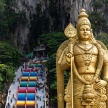Kandhasastikavasam: A Devotional Hymn to Lord Murugan
meaning of song

Introduction
Kandhasastikavasam, also known as Kandha Sashti Kavasam, is a revered devotional hymn dedicated to Lord Murugan, a prominent deity in Hinduism. Composed in Tamil, this hymn consists of eight stanzas, each praising the various attributes and manifestations of Lord Murugan. It is widely recited by devotees seeking his blessings, protection, and spiritual guidance.

Historical and Cultural Significance
The origins of Kandhasastikavasam can be traced back to ancient Tamil Nadu, a region steeped in the rich tapestry of Hindu culture and spirituality. Lord Murugan, often depicted as a youthful warrior riding a peacock, holds a special place in the hearts of millions of devotees, especially in South India and Sri Lanka. He is revered for his valor, wisdom, and divine grace, and is believed to protect his devotees from harm and bestow blessings upon them.

Structure and Content
The hymn comprises eight stanzas, each exuding profound devotion and reverence towards Lord Murugan. These stanzas are written in a poetic and rhythmic style, making them conducive for chanting and recitation. Each stanza is a reflection of the multifaceted nature of Lord Murugan, celebrating his divine attributes and the symbolism associated with him.
- Praise for Lord Murugan's Valor and Divine Form
The first stanza commences with an invocation to Lord Murugan, extolling his valor as a fearless warrior. It vividly describes his divine form, with his six faces and twelve hands, each holding a powerful weapon. This imagery evokes a sense of awe and reverence, portraying Lord Murugan as a formidable and protective deity.
- The Divine Spear and Its Symbolism
The second stanza focuses on Lord Murugan's iconic weapon, the Vel (spear). It elucidates the significance of the Vel in dispelling ignorance and darkness. The stanza portrays the Vel as a beacon of spiritual enlightenment, illuminating the path for devotees and vanquishing the forces of negativity.
- Lord Murugan as the Embodiment of Compassion
The third stanza delves into Lord Murugan's compassionate nature. It describes him as the one who listens to the prayers of his devotees and bestows them with his benevolent blessings. This stanza resonates with devotees seeking solace, comfort, and divine intervention in their lives.
- The Divine Conch and Peacock
The fourth stanza introduces Lord Murugan's vahana (sacred vehicle), the peacock, and his conch. It highlights the symbolism behind these creatures, portraying the peacock as a symbol of pride and the conch as an emblem of victory. This stanza underscores the harmonious interplay of various elements in Lord Murugan's divine presence.
- The Lord of the Hills
The fifth stanza pays homage to Lord Murugan's association with the sacred hills, particularly Arunachala and Palani. It portrays him as the divine guardian of these hallowed landscapes, radiating his blessings to pilgrims and devotees who seek solace in the serene heights of these mountains.
- Lord Murugan's Triumph over Demons
The sixth stanza narrates the legendary battle between Lord Murugan and the demon Surapadman. It vividly portrays the triumph of good over evil, with Lord Murugan emerging victorious. This stanza serves as a powerful reminder of the Lord's unwavering commitment to protecting his devotees from malevolent forces.
- The Lord's Ever-Present Grace
The seventh stanza emphasizes Lord Murugan's omnipresence and his willingness to extend his divine grace to all who seek it. It conveys the idea that regardless of one's circumstances or challenges, Lord Murugan is always accessible and ready to offer his blessings.
- A Final Invocation and Benediction
The eighth and final stanza serves as a culmination of the hymn's devotional fervor. It offers a final prayer for Lord Murugan's blessings, seeking his guidance and protection for all devotees. This stanza encapsulates the essence of the hymn, leaving devotees with a profound sense of spiritual connection and gratitude.

Conclusion: Eternal Devotion to Lord Murugan
Kandhasastikavasam stands as a timeless testament to the deep-seated devotion and reverence that millions of devotees hold for Lord Murugan. Through its poetic verses, it weaves a tapestry of spiritual connection, inviting devotees to immerse themselves in the divine presence of this revered deity. Whether recited in temples, homes, or during pilgrimage, this hymn continues to serve as a source of solace, inspiration, and unwavering faith for generations of devotees across the world.
About the Creator
Veerakarthick Veeramanikandan
freelancer looking for job






Comments
There are no comments for this story
Be the first to respond and start the conversation.